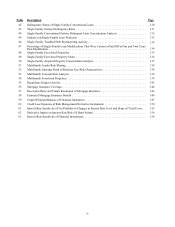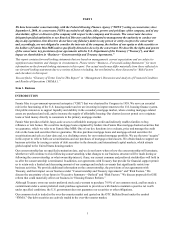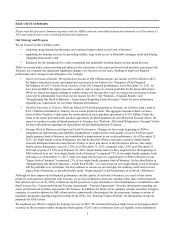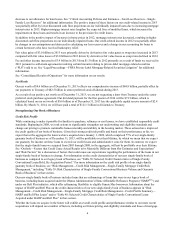Fannie Mae 2013 Annual Report Download - page 15
Download and view the complete annual report
Please find page 15 of the 2013 Fannie Mae annual report below. You can navigate through the pages in the report by either clicking on the pages listed below, or by using the keyword search tool below to find specific information within the annual report.10
Liquidity
During 2013, we issued a variety of non-callable and callable debt securities in a wide range of maturities to achieve cost-
efficient funding. We believe that our ready access to debt funding in recent years has been primarily due to the actions taken
by the federal government to support us and the financial markets. Accordingly, we believe that continued federal
government support of our business and the financial markets, as well as our status as a GSE, are essential to maintaining our
access to debt funding. Changes or perceived changes in federal government support of our business and the financial
markets or our status as a GSE could materially and adversely affect our liquidity, financial condition and results of
operations, or our ability to continue as a going concern. Demand for our debt securities could decline in the future, as the
Administration, Congress and our regulators debate our future. See “MD&A—Liquidity and Capital Management—Liquidity
Management” for more information on our debt funding activities and “Risk Factors” for a discussion of the risks to our
business posed by our reliance on the issuance of debt securities to fund our operations.
Outlook
Uncertainty Regarding our Future Status. We expect continued significant uncertainty regarding the future of our company
and the housing finance system, including how long the company will continue to be in its current form, the extent of our role
in the market, what form we will have, what ownership interest, if any, our current common and preferred stockholders will
hold in us after the conservatorship is terminated and whether we will continue to exist following conservatorship.
We cannot predict the prospects for the enactment, timing or content of legislative proposals regarding long-term reform of
the GSEs or the housing finance system. See “Housing Finance Reform” for a discussion of proposals for GSE reform that
could materially affect our business, including bills introduced in Congress that, among other things, would require the wind
down of Fannie Mae and Freddie Mac. See “Risk Factors” for a discussion of the risks to our business relating to the
uncertain future of our company.
Financial Results. Our financial results continued to be strong in 2013, with pre-tax income of $38.6 billion and net income
of $84.0 billion. We expect to remain profitable for the foreseeable future. While we expect our annual earnings to remain
strong over the next few years, we expect our net income in future years will be substantially lower than our net income for
2013. The following factors contributed to a large portion of our 2013 net income: the release of the valuation allowance
against our deferred tax assets, which contributed to a benefit for federal income taxes of $45.4 billion for the year;
substantial credit-related income resulting from the substantial decrease in our loss reserves during the year; and the large
number of resolutions we entered into during the year relating to representation and warranty matters and servicing matters.
Although we expect to continue to enter into resolution agreements and may have credit-related income in future years, we
expect these factors will have a smaller impact on our earnings in future years than in 2013. In addition, as of December 31,
2013, we no longer have a significant valuation allowance against our deferred tax assets. Our future earnings also will be
affected by a number of other factors, including: changes in home prices; changes in interest rates; our guaranty fee rates; the
volume of single-family mortgage originations in the future; the size, composition and quality of our retained mortgage
portfolio and guaranty book of business; and economic and housing market conditions. Some of these factors, such as
changes in interest rates or home prices, could result in significant variability in our earnings from quarter to quarter or year
to year. For a discussion of our expectations regarding our future revenues, see “Strengthening Our Book of Business.”
Dividend Obligations to Treasury. In compliance with our dividend obligation to Treasury, we will retain only a limited
amount of any future earnings because we are required to pay Treasury each quarter the amount, if any, by which our net
worth as of the end of the immediately preceding fiscal quarter exceeds an applicable capital reserve amount. This capital
reserve amount is $2.4 billion for each quarter of 2014 and then decreases by $600 million annually until it reaches zero in
2018.
From 2009 through the first quarter of 2012, we received a total of $116.1 billion from Treasury under the senior preferred
stock purchase agreement. This funding provided us with the capital and liquidity needed to fulfill our mission of providing
liquidity and support to the nation’s housing finance markets and to avoid a trigger of mandatory receivership under the
Federal Housing Finance Regulatory Reform Act of 2008 (the “2008 Reform Act”). In addition, a portion of the $116.1
billion we received from Treasury was drawn to pay dividends to Treasury because, prior to 2013, our dividend payments on
the senior preferred stock accrued at an annual rate of 10%, and we were directed to pay these dividends to Treasury each
quarter even when we did not have sufficient income to pay the dividend. We have not received funds from Treasury under
the agreement since the first quarter of 2012. From 2008 through 2013, we paid a total of $113.9 billion in dividends to
Treasury under the senior preferred stock purchase agreement. In March 2014, we will pay Treasury additional senior
preferred stock dividends of $7.2 billion for the first quarter of 2014. With this dividend payment, we will have paid a total of
$121.1 billion in dividends to Treasury on the senior preferred stock. Under the terms of the senior preferred stock purchase
























